

The Pyramid of Cestius is a Roman funerary monument located in Rome, Italy. It is a rare example of a pyramid built in the ancient Roman world. The pyramid stands at a height of approximately 125 feet and is constructed of concrete and brick. It was built around 12BC and is believed to be the tomb of Gaius Cestius, a magistrate and member of the Septimii, a powerful family during the late Republic. The pyramid is built in the traditional Egyptian style, with four triangular faces. Each face is framed with large blocks of travertine, and the sides are decorated with Corinthian pilasters. The pyramid is topped with a pyramidion, or capstone, which is made of white marble and decorated with a bronze chariot and four horses. The pyramid has also been decorated with painted stucco, which is still visible in some places. The Pyramid of Cestius is one of the few surviving examples of a Roman pyramid. It is a unique example of an ancient Roman funerary monument.

The Colosseum is one of the most iconic and prolific historic buildings in Rome. Built in the 1st century AD, it was initially known as the Flavian Amphitheatre, named after the ruling dynasty of the time, the Flavians. It is located just east of the Roman Forum and was constructed by Emperor Vespasian of the Flavian dynasty in 72 AD, with the intent of showcasing the grandeur and power of the Roman Empire. The Colosseum is an immense building, measuring 188m long, 156m wide and 48m high. It was designed to be an elliptical amphitheatre, with a capacity of over 50,000 spectators. The exterior of the Colosseum is constructed of concrete and stone, with four tiers of arches and Doric, Ionic and Corinthian columns. The upper tier of the Colosseum is adorned with statues of Roman gods, goddesses, and emperors, and the interior is decorated with marble, stucco and mosaics.
The Colosseum was used primarily for entertainment, where spectators watched gladiatorial battles and other public spectacles such as animal hunts, plays and executions. It could also be used to host large religious ceremonies. The Colosseum had a complex system of underground tunnels and chambers, which were used to store animals and equipment for the shows, as well as to allow for the quick removal of the dead bodies after the shows.
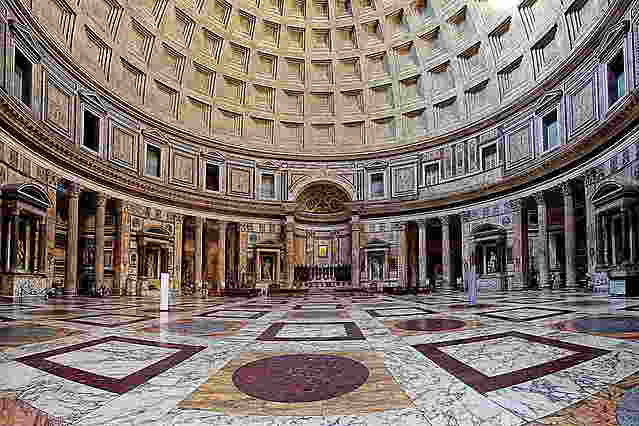
The Pantheon is a historic building in Rome, Italy that was originally built as a temple to all of the Roman gods. It is one of the most well-preserved ancient Roman buildings, and is one of the most visited tourist destinations in Rome. The Pantheon was built between 118 and 125 AD, during the reign of Emperor Hadrian. It is a circular building with a concrete dome, and is one of the largest free-standing domes in the world. The Pantheon is 43.3 meters in diameter, and the dome is 43.2 meters high. The dome is made of brick and concrete, and features a central opening called the oculus, which is 8.8 meters in diameter. The interior of the Pantheon is decorated with statues, reliefs, and other artwork, many of which are original works from ancient times. It also features a coffered dome, which is a series of coffers or sunken panels in the ceiling. The Pantheon also features an altarpiece of the Virgin Mary and Child, which was added in the 16th century.

Castel Sant’Angelo is one of the most iconic historic buildings in Rome, Italy. It sits atop the banks of the Tiber River, just across from St. Peter’s Basilica, and is a prominent feature of the city’s skyline. The castle was originally built by the Roman Emperor Hadrian as a mausoleum for himself and his family. It was later used as a fortress and prison during the Middle Ages, and was eventually converted into a papal residence in the 16th century. The building is a cylindrical structure, built with travertine stone and capped with a large bronze statue of the archangel Michael. It stands at a height of 121 feet and is surrounded by a wide moat, spanned by a drawbridge. The interior of the castle is divided into various floors, each with its own purpose. On the first floor, visitors can find the Hall of the Angels, a large room that was once used by the papal court. On the second floor is the State Apartments, a series of rooms that were used by the Pope and other members of the papal court. The castle also contains a number of historical artifacts and works of art. These include the frescoes of Luca Signorelli, a 15th-century painter, and the sculptures of Gian Lorenzo Bernini, a renowned Baroque artist.

The Arch of Constantine is a triumphal arch located in Rome, Italy, that is dedicated to the Roman emperor Constantine. Built in the early 4th century, it is one of the most famous and well-preserved monuments in the city. The arch stands 21 meters (70 feet) high and 25.7 meters (85 feet) wide, with three arches on the façade. It is located near the Colosseum, along the Via Triumphalis, the road used for triumphal processions. The arch is decorated with a variety of reliefs and sculptures, many of which were taken from earlier monuments from the 2nd and 3rd centuries. This is indicative of the reuse of earlier material that was common during Constantine’s reign, when he was trying to restore Rome’s imperial glory. The reliefs depict a variety of scenes from the life of Constantine, including his victory in the Battle of Milvian Bridge, his proclamation as emperor, and his triumphal entry into Rome.

The Church of Santa Costanza is a 4th-century church located in Rome, Italy. It is a prime example of early Christian architecture, and is one of the finest surviving examples of its kind. The church was originally built by Emperor Constantine to house the remains of his daughter, Constantina, who was martyred in 326 AD. The exterior of the Church of Santa Costanza features a circular plan with a central rotunda. The building is constructed of brick and tufa, a type of volcanic stone. The rotunda is surrounded by four large apses, which were used as burial chambers for the imperial family and as chapels for worship. The roof of the church is topped with a large domed cupola and is decorated with intricate mosaic patterns.
The interior of the Church of Santa Costanza features a single nave, which is lined with 12 Corinthian columns. The walls of the nave are decorated with marble and mosaics, and the floor is made of geometric and floral patterns. At the center of the nave is the main altar, which is decorated with a mosaic depicting the martyrdom of Constantina. The Church of Santa Costanza is best known for its beautifully preserved early Christian mosaic, which dates to the 4th and 5th centuries. The mosaics depict biblical scenes, such as the Transfiguration of Christ and the Ascension, as well as scenes of Constantina’s martyrdom. The mosaics are some of the finest surviving examples of early Christian art.

The Tempietto di San Pietro in Montorio is a small but historically significant Renaissance building located in the courtyard of the Church of San Pietro in Montorio in Rome, Italy. Built in the early 16th century, it is a masterpiece of classical Roman architecture, designed by the renowned Italian architect Donato Bramante. The Tempietto is a circular structure, built on a high platform with a tiled roof. It is circular in shape, and just over nine meters in diameter. The exterior walls are built of travertine stone, and the interior is decorated with a series of pilasters. The overall effect is a classic Renaissance style, with the grandeur of a classical temple. The Tempietto is crowned by a dome, with its interior painted with frescoes. The Tempietto was commissioned by Pope Julius II in 1502, and was intended as a shrine to commemorate the death of Saint Peter, the first pope. It was built on the site where, according to tradition, Saint Peter had been martyred and buried. The Tempietto was intended to be a timeless monument to the power of the papacy. In the centuries since its construction, the Tempietto has become an iconic symbol of the city of Rome and a symbol of the city’s rich cultural heritage. It has been designated as a World Heritage Site by UNESCO, and is often cited as one of the most important examples of Renaissance architecture.
Villa Farnesina is a historic building located in Rome, Italy. It was commissioned by the wealthy banker Agostino Chigi and designed by the architect Baldassarre Peruzzi in the early 1500s. The building is renowned for its Renaissance-style architecture and ornate frescoes and decorations. The most famous frescoes are found in the Loggia of Galatea, which were painted by Raphael, Sebastiano del Piombo, and Giulio Romano. These frescoes depict the myth of Galatea, a sea nymph who was loved by the god of the sea. Other frescoes in the villa were painted by Baldassarre Peruzzi and the Flemish painter Jan Mabuse. The villa also features a series of terraces and gardens, which overlook a large pond. The pond is surrounded by sculptures and fountains and offers stunning views of Rome. The villa is located in the Trastevere area of Rome and is one of the most historically significant buildings in the city. It was once owned by the Farnese family, one of the most powerful families in Renaissance Rome. The villa is now owned by the Italian government and is open to the public as a museum.
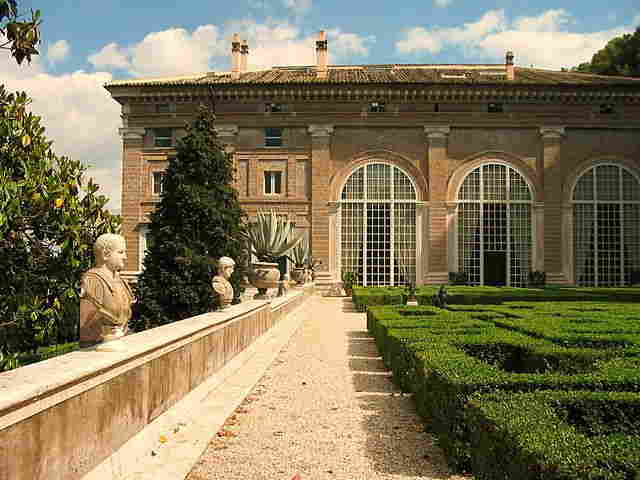
Villa Madama is an iconic historical building located in Rome, Italy. Built in 1518, it was originally commissioned by Cardinal Giulio de’ Medici, who later became Pope Clement VII. The villa was designed by the renowned Renaissance architect, Raphael Sanzio, and is widely considered to be a masterpiece of the Italian Renaissance. Villa Madama is renowned for its exquisite design, which was heavily influenced by classical antiquity. The building is symmetrical and features a grand open courtyard. The main facade is flanked by two large towers, which are topped by a terrace. From the terrace, one can admire the breathtaking views of the surrounding countryside. Inside, the villa is filled with beautiful frescoes, sculptures, and paintings by masters such as Raphael, Giulio Romano, and Il Sodoma. The villa underwent extensive renovations in the 19th century, and today it is a popular tourist attraction.

Palazzo dei Conservatori del Campidoglio is a historic building located at the top of the Capitoline Hill in Rome, Italy. The building is part of the Capitoline Museums and is a notable example of Renaissance architecture. The Palazzo was commissioned by Pope Sixtus IV in 1471 and was designed by architects Baccio Pontelli and Giacomo della Porta. The Palazzo stands as a testament to the great accomplishments of Renaissance architecture, depicting an impressive blend of elements from antiquity and the contemporary period. The Palazzo dei Conservatori is constructed of travertine, with a façade consisting of five bays with a portico supported by Corinthian columns. The first two bays are decorated with statuary, with the central bay featuring a large window flanked by two smaller windows. The second floor of the building has a balcony with balusters and a balustrade of terracotta statues. The interior of the Palazzo is laid out in a series of interlinking rooms, and is decorated with a variety of Renaissance frescoes and paintings. Of particular interest are the frescoes by Raphael, which depict scenes from Roman history. There are also numerous works of art by other renowned Renaissance artists, including Michelangelo and Giulio Romano.
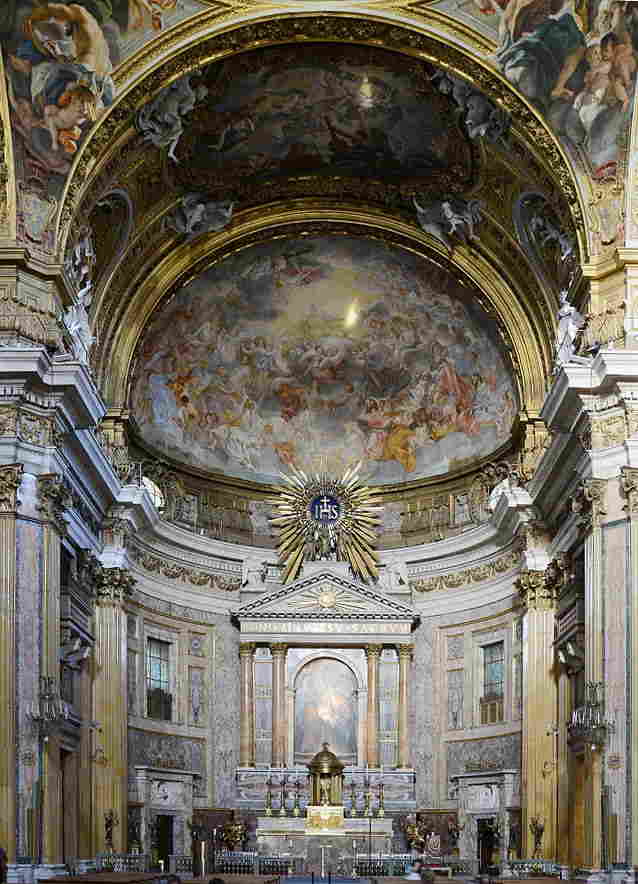
The Church of Il Gesù is a historic Roman Catholic church located in Rome, Italy. Built in the 16th century, it is considered to be one of the most important examples of Italian Baroque church architecture. The church was commissioned by Pope Julius II in 1568 and was designed by Giacomo della Porta in collaboration with Vignola and Giacomo Barozzi da Vignola. The Church of Il Gesù is a prominent example of the Counter-Reformation style of architecture. It was designed to be a symbol of the Catholic Church's triumph over the Protestant Reformation and to reinforce the faith of the people.
The church is richly decorated with frescoes, paintings and sculptures, many of which were created by artists of the period such as Giovanni Baglione, Domenichino and Andrea Pozzo. The façade of the church is particularly noteworthy and features a large central window with two smaller windows on either side. The interior of the church is also highly decorated, with a grand high altar and a number of side altars. The main altar is dedicated to the Virgin Mary and the side altars are dedicated to various saints, including St. Ignatius of Loyola, St. Francis Xavier and St. Ignatius of Antioch. The Church of Il Gesù has been designated as a UNESCO World Heritage Site and is one of the most visited religious sites in Rome. It is also home to several important works of art, including the large painting “The Death of St. Ignatius” by Andrea Pozzo and the “Holy Family” by Carlo Maratta.

San Carlo alle Quattro Fontane is a historic building located in Rome, Italy. It is a Baroque church designed by the architect Francesco Borromini in 1638-1641. It was commissioned by Pope Urban VIII and dedicated to the Virgin Mary. The church is a unique example of Baroque architecture, characterized by its distinctive oval shape, concave façade, and four fountains located at the four corners of the building. The façade is decorated with elaborate stucco work and sculptures, while the interior is characterized by its curved walls and dome. The church was designed in the form of a Greek cross, with the central dome set on four columns. The interior of the church is divided into three sections, with the central nave being the most ornate. The side aisles are decorated with frescoes and sculptures created by Carlo Maratta, and the altarpiece is a work by Baciccio.
The church also contains several paintings by Caravaggio and his followers. The exterior of the church is defined by its four fountains, which are meant to represent the four rivers of the world. The fountains are made of travertine and are set in an oval pool, with two of them being larger than the other two. The fountains are decorated with sculptures by Alessandro Algardi, and the entire building is surrounded by a wall adorned with statues. San Carlo alle Quattro Fontane is a unique example of Baroque architecture and is considered one of the most important churches in Rome. Its distinct shape and elaborate decorations make it a popular tourist destination, and it is recognized by UNESCO as a World Heritage Site.

The Church of San Ivo alla Sapienza is a historic religious building located in Rome, Italy. Built in the 17th century, the church has a long and fascinating history. The church was designed by the renowned Italian architect Carlo Maderno and was originally commissioned by Pope Paul V. The church is dedicated to St. Ivo, who was a 12th-century Breton saint and a lawyer and a theologian. The Church of San Ivo alla Sapienza is a classic example of Baroque architecture, featuring a central dome, two bell towers, and a grand facade. The facade is decorated with sculptures of St. Ivo, various angels, and a statue of the Virgin Mary, all of which are framed by an ornate portico. Inside the church, there are numerous frescoes, marble carvings, and other works of art. The Church of San Ivo alla Sapienza has been an important religious site for many centuries. It has been a destination for pilgrims, a site of important papal ceremonies, and a place of refuge during times of political unrest. Over the centuries, the church has been restored and refurbished, but its original design and structure remain largely intact.
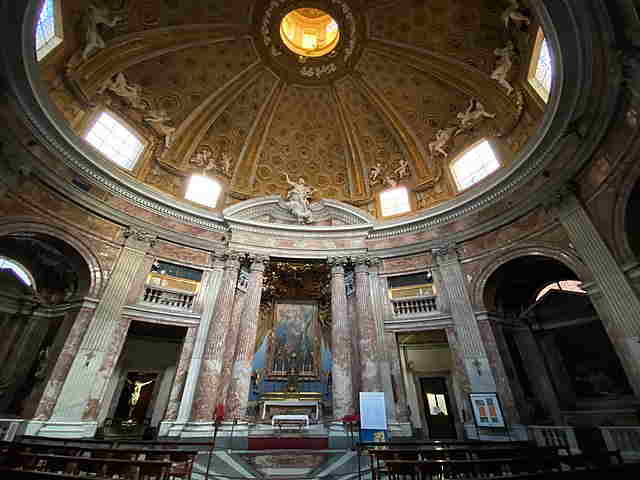
The Church of Sant' Andrea al Quirinale is a historic building located in Rome, Italy. It is a Roman Catholic Church and a minor basilica. The Church was built in the 17th century and dedicated to St. Andrew the Apostle. It was designed by the renowned Italian architect Gian Lorenzo Bernini and completed in 1658. The Church is known for its remarkable Baroque architecture and is often described as a masterpiece of the period. The Church was built on the site of an earlier church which dated back to the 15th century and was dedicated to St. Andrea Corsini.
The original church was destroyed by a fire in 1641 and the decision was made to construct a new building. Bernini was chosen to design the new structure and he created a stunning Baroque building which featured a large dome, grand belltower and a stunning façade. The façade of the Church is composed of two stories and is adorned with Corinthian columns and a balustrade. The interior of the Church is equally impressive with its marble floor, high ceiling and impressive altar. The main altar is in the shape of a Latin cross and is adorned with bronze statues. The Church also features a number of side chapels where visitors can admire the work of other prominent Baroque artists such as Carlo Maratta and Domenico Guidi. The Church of Sant' Andrea al Quirinale is a stunning example of Baroque architecture and is one of the most important churches in Rome.
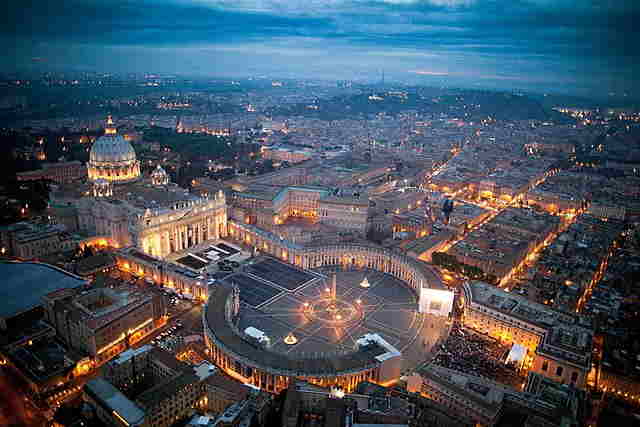
The Colonnade of St. Peter is a historic building located in the Vatican City in Rome, Italy. It is an open-air structure that was commissioned by Pope Alexander VII in the 17th century and consists of four rows of Doric columns. The Colonnade of St. Peter was designed by Gian Lorenzo Bernini and is considered to be one of the most impressive examples of Baroque architecture. The structure is made up of 284 columns in total that are arranged in four rows of 71 each, and is located around the Ellipse of St. Peter, a large circular area. The columns are connected by arches and the whole structure is crowned with a balustrade. The Colonnade of St. Peter is considered to be one of the most iconic landmarks in Rome and is a must-see for any visitor to the city.
The Colonnade of St. Peter is a stunning example of Baroque architecture and its design is meant to symbolize the embrace of the Catholic Church. The columns are decorated with symbols of the holy family, the apostles and saints, and the structure is meant to be an expression of the Church’s power and influence. The Colonnade of St. Peter is also an important piece of history. It was originally built to provide a space for pilgrims to visit and to celebrate the Jubilee of 1650. Since then, it has become a symbol of the Catholic Church and a popular tourist attraction.

Ufficio Postale is an historic building located in the heart of Rome, Italy. Built in the late 19th century, the building was originally designed to serve as the main post office for the city. The Romanesque style building features a facade of red brick, white marble, and travertine, with a prominent clock tower that stands over the entrance. Inside, the building is adorned with frescoes, statues, and other ornamental designs. The building also contains a number of services, including a post office, a money order office, a telephone exchange, and a telegraph office. The building was commissioned by the Italian government in 1885 and completed six years later in 1891. It was designed by the architect, Edoardo D'Este, and features a distinctive clock tower at the front of the building. The clock is decorated with a large bronze bell that rings out every hour, telling the time to the citizens of Rome. The building also features a large open courtyard, which is used for public gatherings and performances. Throughout its history, Ufficio Postale has been used for a variety of purposes. During World War II, it served as a headquarters for the Italian military. After the war, the building was used as a government office, a library, and a museum. In recent years, the building has been renovated and now serves as a cultural center, hosting a variety of events and exhibitions.

Palazzetto dello Sport is an iconic historic building located in Rome, Italy. It was originally built in the mid-1960s and is the home of the Italian basketball team. The building was designed by Pierluigi Nervi and is an example of Brutalist architecture, a style of architecture characterized by large, block-like forms and the use of exposed concrete. Palazzetto dello Sport is a large building that is composed of two main parts: a large, circular arena and a smaller, rectangular building. The arena is made up of two distinct levels, the upper and lower tiers, which together make up the seating area. The upper tier has a capacity of 8,000 people, while the lower tier has a capacity of 3,000 people. The upper tier also houses a press area and VIP boxes. The smaller rectangular building houses the locker rooms, offices and other facilities. The exterior of the building is composed of exposed concrete, which gives it a modern and bold appearance. The building is also decorated with mosaic tiles and a large, colorful mural. In addition, the building has a large, arched entrance and a series of windows which provide natural light.

Parco della Musica Auditorium is a historic building located in the heart of Rome, Italy. It was designed by renowned Italian architect Renzo Piano and opened in 2002. The auditorium was built as part of a larger cultural complex, the Parco della Musica, which includes a number of performance venues, as well as a park and other recreational facilities. The Parco della Musica Auditorium is an impressive building, with a unique curved form and a striking exterior of glass and metal. The auditorium has three levels, and its interior features an impressive grand staircase and a large, domed ceiling with a special acoustic system. Its acoustics have been acclaimed by some of the world's greatest musicians, including Luciano Pavarotti, who said it was the best auditorium he had ever performed in. The auditorium has a capacity of up to 2,500 people, making it an ideal venue for large concerts, operas and theatrical performances. It has hosted some of the biggest names in music, including Elton John, Deep Purple and Sting. It is also a popular venue for classical music events, such as the annual Roman Summer Festival. The Parco della Musica Auditorium is a wonderful example of modern Italian architecture and a popular tourist attraction in Rome. It has become a symbol of the city's vibrant cultural life and a testament to the city's importance in the world of music.
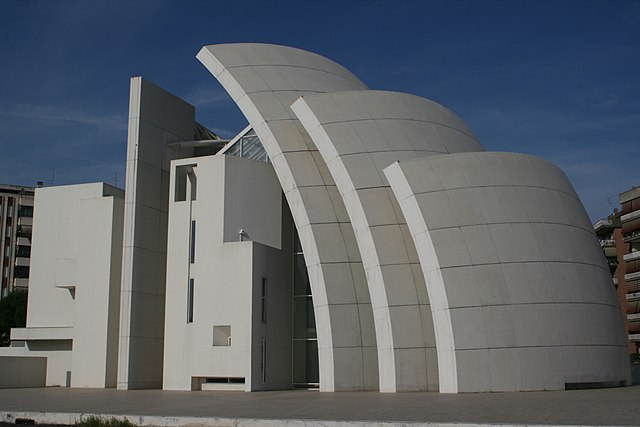
Jubilee Church, also known as Chiesa di Dio Padre Misericordioso (Church of God the Merciful Father), is a stunning modern architectural masterpiece located in Rome, Italy. Designed by renowned architect Richard Meier, the church stands as a symbol of contemporary religious architecture and was constructed to commemorate the Jubilee Year 2000, a special Holy Year in the Roman Catholic Church.
Completed in 2003, Jubilee Church is situated in the Tor Tre Teste neighborhood of Rome. Its unique design is characterized by a striking white concrete exterior, which gleams in the sunlight and stands out amidst the traditional Roman surroundings. The church's clean lines, soaring curves, and emphasis on natural light create a harmonious and tranquil space for worship and contemplation.
The most distinctive feature of Jubilee Church is its three large, curving sails that rise dramatically into the sky. These sails are made of a translucent glass and fiberglass material, allowing daylight to filter through and illuminate the interior, symbolizing the divine light and spirituality. The sails also serve a practical purpose, acting as canopies that shield the church's outdoor gathering space from the elements.
As visitors enter the church, they are met with a sense of openness and serenity. The interior is vast and airy, with the white surfaces and natural light creating a sense of purity and spiritual transcendence. The central nave is flanked by side aisles, with the altar positioned beneath a circular skylight that showers the space with a celestial glow.
In addition to its architectural brilliance, Jubilee Church is renowned for its innovative use of sustainable design elements. Rainwater harvesting and solar panels contribute to the church's eco-friendly footprint, aligning with Pope Francis's call for environmental stewardship and care for the planet.